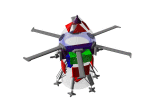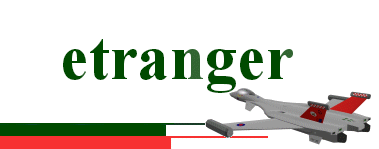
Roton
By Jonathan Pearson
AcknowledgementsLaurent Esmiol for correcting my French.
Contents- Introduction
- Narrative
- Development
- Configuration
- Mission Profile
- Service History
- Statistics
- Glossary
- Design Notes
The Roton is a class of vertical take off and landing (VTOL) interface vehicle. Unlike other interface vehicles it is based upon a helicopter concept rather than an aeroplane or missile form.
The Roton was first developed as a usable interface vehicle by Flame Spiral Industries of New Zealand. The relatively small market for such vehicles has meant that FSI remain the dominant supplier of Rotons to the civilian market. FSI have however licensed their technologies and designs to a wide range of companies of various nationalities.
The VTOL ability of the Roton makes it ideal for military landing operations as it is capable of landing on unprepared ground. In addition the Roton can operate equally well within a vacuum (unlike aeroplane based interface vehicles) making it a very flexible asset.
The aerospace division of Canadian industrial conglomerate Gunner-Long produce the most popular versions of the Roton for military use - the GLR-GA, GLR-MU and the GLR-MT. The GLR-GA, exported as the Ouragan (Fr: Hurricane), is an armed version of the roton equipped with a combined point defence / ground attack dual plasma gun system capable of delivering combat troops or equipment from orbit into a medium to low threat landing zone. The GLR-MU, exported as the Cyclone, is an unarmed version of the GLR-GA while the GLR-MT, exported as the Tourbillon (Fr: Whirlwind), is a dual contra-rotating rotor transport capable of moving 500 tonnes from orbit to a low threat landing zone.
NarrativeEnseigne Jeannette Montcalme switched her virtual cockpit over to tactical to watch the progress of "Les Paras" towards the tertiary landing zone. The Roton's EW system queried the troops IFF transponder and updated the position on her plot - about 10 minutes to rendezvous.
The previous evening her Ouragan had delivered the same men and women to a small forest clearing from the troopship orbiting Joi. The autopilot had dropped the Roton into the clearing with so little disturbance that that the roosting flying foxes barely bothered to open their eyes to watch the alien vessel descend. Jeannette had toggled the exit ramp while her gunner monitored the passive sensors for any sign of Elysian rebels ("les grenouille" as the Paras called them). When Rabea reported that there was no rebel activity visible on any of the spectra available to her Jeannette had informed Capitaine Mejdoub that his mission was a go.
Giving her head a quick shake to dismiss her recollections Jeannette scanned the display once more for signs of the Paras' pursuers. Although the landing had gone undetected the Paras' approach to the rebel base had been spotted by a grenouille LTA drone operating beneath the forest canopy. Unfortunately the Paras had not spotted the drone and had walked straight into an ambush. They had managed to break contact but had been cut off from their primary and secondary pickups by a second group of grenouille returning from a patrol. With no enemy icons on her display Jeannette told the autopilot to begin final approach. She often wondered what purpose she served sitting in the Ouragan's control cabin as the Roton had all the manoeuvrability of a flying brick and only two directions of travel - straight up and straight down! Nevertheless MSF regulations required that all passenger carrying interface vehicles should have a human pilot so here she was.
"I've got the
Paras on visual" reported Rabea as the tac display updated itself.
"Mon Dieu!" Jeannette
swore under her breath as a grenouille recon drone also appeared on the
plot and the EW alarm began to chime in her left ear. "Rabea,
go active on the array and loose that drone" she ordered her gunner.
"Tango Delta to
Alpha Uniform we have been acquired, what is your situation? Over."
"Alpha
Uniform, hostiles on foot two klicks out. Over."
The encrypted comm meant that Jeannette was unable to tell if it was Mejdoub on the other end of the link, she hadn't had a status update on the Paras casualties as they'd lost their long range comm in the ambush.
Jeannette's tactical display had been updated by the phased array radar activated by Rabea and showed two other grenouille drones (both recon versions fortunately) in detection range. She also felt the thud through her flight seat as the two plasma guns deployed on their pylons. Two seconds later the first recon drone disappeared from the plot incinerated by two plasma bolts.
"Alpha Uniform,
we have you on visual. Over."
"Tango
Delta to Alpha Uniform we're coming in. Get your arses over here now."
Jeannette hit the landing site icon on her display and told the autopilot "Max descent rate." Her stomach lurched towards her throat as the Roton dropped out of the sky and moments later reversed direction as the rotor tip rockets fired to lower the Ouragan gently to the ground as the landing feet deployed. Leaving Rabea to monitor the tac display she cycled through the external camera views watching the Paras running for the loading ramp carrying their wounded with them while the rear guard deployed at the edge of the clearing.
"Alpha Uniform
to Tango Delta, we're taking ground fire here preparing to withdraw in
30."
"Rabea,
put the guns in ground mode and give covering fire."
The external cameras showed Jeannette the port plasma gun rapid firing towards the tree line. The plasma bolts splashed into the edge of the forest over the heads of the retreating Paras. Red glowing plaser cartridges cascaded onto the ground below the gun causing the mat of grass-vine to smoulder. Splitting her view to bring up flight ops. Jeannette instructed the autopilot to spin up the rotor ready for a quick liftoff.
"Incoming mortar
rounds!" Rabea announced, the pitch of her voice rising with the tension.
"Leave
the guns on the ground, let the PD laser take them." Jeannette ordered.
From the tip of
the Roton's nose the laser mirror tracked round towards the approaching
bombs, invisible beams stabbed out.
"Two
down, four remaining.... two.... one.... last one's going wide." Rabea
chanted.
The roton rocked as the final mortar bomb exploded 30 metres away. Jeannette switched to the status display - no red lights, a couple of ambers on the primary APU.
"We're all aboard." came Mejdoub's voice on the internal comm. Jeannette grinned and hit the commit button on her ops display. The angle of attack of the roton's rotor blades tilted up and bit the air throwing the Ouragan into the air and away from the Elysian forest and the grenouilles. The roton climbed into the cloudy sky but just as Jeannette began to relax the SAM launch alarm began to chime and her display automatically switched to tac mode.
"Rabea make sure the guns are back in PD mode." Jeannette called up the counter-measures program and watched the display as the EW focussed on the incoming missiles and the dispensers began to release flares and decoys. Despite the best efforts of the system only two of the SAMs were distracted and the two others continued to bore in - the roton was a big target and not capable of evasive manoeuvres.
Feeling useless, and very vulnerable, she watched as the Ouragan's radar's locked on to the missiles and, as they came into range, engaged them with the two plasma guns.
"Splash two vampires." breathed Rabea as the icons for the final two missiles disappeared from the display.
The roton continued it's climb to orbit, otherwise unmolested, leaving the forest below to the attentions of the orbital KE strikes. The grenouilles however had quickly dispersed once they had failed to prevent the Ouragan's rescue mission and most of them evaded the retaliation.
DevelopmentGunner-Long have produced Rotons, under license from FSI, for several decades and the GLR-GA, MU and MT models represent the second generation to find service with various militaries. The first generation of vehicles were simply militarisation of existing FSI models. Typically FSI would supply the airframe and rotors to which Gunner-Long would fit military standard avionics and comms. Depending upon the customer's requirements various countermeasures were also fitted.
The second generation of Gunner-Long rotons however are much more distinct from their civilian cousins although they continue to share many common features.
GLR-GA Ouragan and GLR-MU Cyclone
The GLR-GA (Ground Assault) and MU (Military Utility) models were developed as part of a joint programme with FSI. The aim of the programme (known as Sycamore) was to produce a common core design which could be adapted to both military and civilian uses while allowing a far greater degree of adaptability than the previous military conversions of civilian models.

